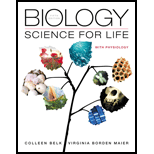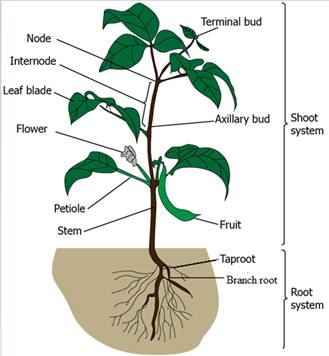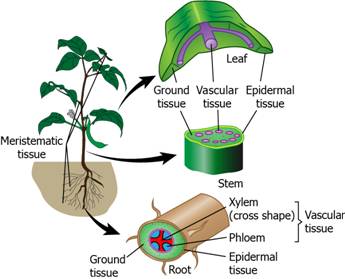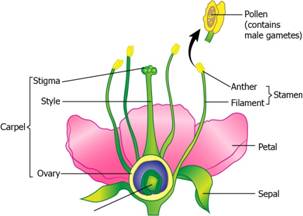
Concept explainers
To describe:
The parts of the plant and the flower.
Introduction:
The plants are the living things, which are able to produce the food by using sunlight, water and carbon dioxide. They synthesize their food in the process known as photosynthesis.
Explanation of Solution
The plant can be broadly divided into two main body, the root system and the shoot system. The root system is the part of the plant present inside the ground and the shoot system is the part of the plant present above the ground. The root has one main body, which is known as the tap root. This body gives rise to the branch roots, which are smaller and widespread in the soil.
The shoot system mainly consists of stem, branches and the leaves. The stem is a long solid pipe like structure that give rise to the branches. The point where a branch emerges from the stem is called node. The space between two nodes is known as the internode. The branches further divided into the flat green surface known as leaf or leaf blade. The flowering plants have a bright color structure called flowers. The flower is the site of sexual reproduction in plants. The fruit is the food storage site of the plants, which are mostly consumed by the heterotrophs.
The stem is a solid structure made of three substances. The outer lining of the stem is known as the epidermal layer. The stem has a bundle of vascular tissues, that is xylem and the phloem and the remaining space is occupied by the ground substance.
A labeled diagram of the plant is given below:


The flower is the site of sexual reproduction in the plants. A typical flower has both male and female reproductive part, but some species may have a single sexual part. The structure of a flower consists of sepal, petal, carpel and stigma. The carpel is the female reproductive part and consists of stigma, style and ovary. The stigma receives the male pollen and style is the tube through which the pollen pass to the ovary. The ovary contains female gametes and ovule. The ovule forms the seed or the embryo. The male part is stamen, which consists of anther and filament. The anther contains the male gamete that is the pollen grain.
A labeled diagram of a flower is given below:

The plant body consists of root and shoot system and the flower consists of sepals, petals, carpel and stamen.
Want to see more full solutions like this?
Chapter 24 Solutions
Biology: Science for Life with Physiology (5th Edition)
- 1. Match each vocabulary term to its best descriptor A. affinity B. efficacy C. inert D. mimic E. how drugs move through body F. how drugs bind Kd Bmax Agonist Antagonist Pharmacokinetics Pharmacodynamicsarrow_forward50 mg dose of a drug is given orally to a patient. The bioavailability of the drug is 0.2. What is the volume of distribution of the drug if the plasma concentration is 1 mg/L? Be sure to provide units.arrow_forwardDetermine Kd and Bmax from the following Scatchard plot. Make sure to include units.arrow_forward
- Choose a catecholamine neurotransmitter and describe/draw the components of the synapse important for its signaling including synthesis, packaging into vesicles, receptors, transporters/degradative enzymes. Describe 2 drugs that can act on this system.arrow_forwardThe following figure is from Caterina et al. The capsaicin receptor: a heat activated ion channel in the pain pathway. Nature, 1997. Black boxes indicate capsaicin, white circles indicate resinferatoxin. a) Which has a higher potency? b) Which is has a higher efficacy? c) What is the approximate Kd of capsaicin in uM? (you can round to the nearest power of 10)arrow_forwardWhat is the rate-limiting-step for serotonin synthesis?arrow_forward
 Biology: The Unity and Diversity of Life (MindTap...BiologyISBN:9781305073951Author:Cecie Starr, Ralph Taggart, Christine Evers, Lisa StarrPublisher:Cengage Learning
Biology: The Unity and Diversity of Life (MindTap...BiologyISBN:9781305073951Author:Cecie Starr, Ralph Taggart, Christine Evers, Lisa StarrPublisher:Cengage Learning





